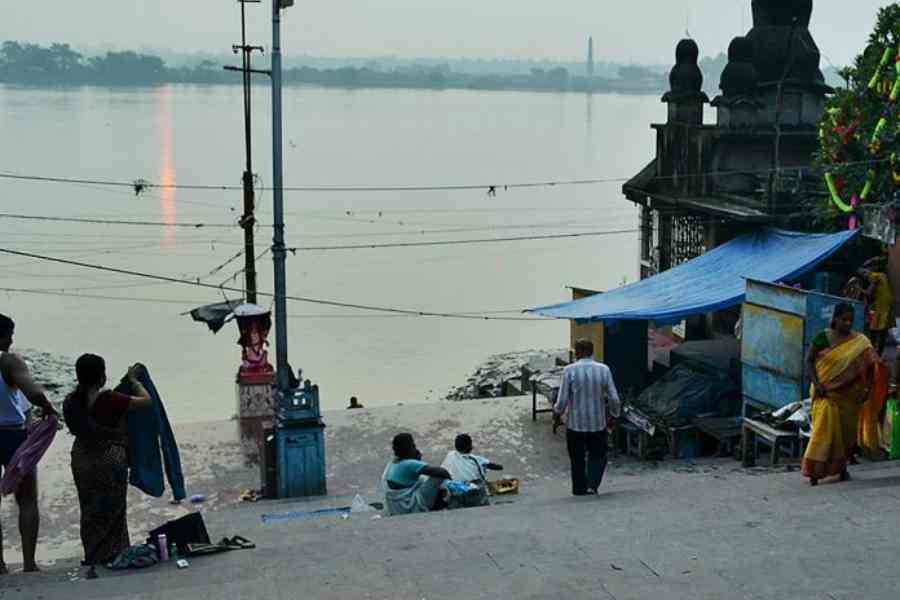In February, the prime minister, Narendra Modi, had expressed his great joy at the revival of the Kumbh Mela pilgrimage in the locality of Tribeni in Hooghly district, West Bengal. At the time, Modi said, “[D]o you know why it is so special? It is special, since this practice has been revived after 700 years… Two years ago, the festival has been started again by the local people and through ‘Tribeni Kumbho Porichalona Shomiti’. I congratulate all the people associated with its organization. You are not only keeping alive a tradition, but are also protecting the cultural heritage of India.” (https://pib.gov.in/PressReleaseIframePage.aspx?PRID=1902487)
The historical fact is that there never was a Kumbh Mela at Tribeni, and the so-called ‘revival’ is based on falsified research. I say this with confidence since the source of this disinformation is a sentence in my doctoral dissertation at Oxford University that someone doctored and then circulated widely. My research focused on pilgrimage traditions in West Bengal and is available on the internet in digital form from the Bodleian Library at Oxford. Someone with an agenda got hold of my dissertation and reworded the page where I discuss Tribeni to say what they wanted to say, not what I had written based on my years of research on the subject.
I had written that every period of solar transition (sankranti) was “auspicious for a bath in the Ganges.” The original phrase appeared in brackets; the forgers removed my words and fit within those brackets the words: “a Kumbha-mela was held here in past.” My phrase and theirs both total 29 characters. If I had written it, I would have included the definite article before “past” but they didn’t have room for that. Somewhat impressively, the forgers sourced the correct font as well, which might not have been easy to find since the original was typed on an electronic typewriter, not a computer. On looking at it, no one would have any inkling that it was a forgery. I would be impressed if I wasn’t disgusted.
The altered page was circulated widely by Hindu supremacists as justification for ‘reviving’ a major Hindu pilgrimage at Tribeni. That location has, indeed, been a pilgrimage site, and in my research I identified it as being one of only two places in Bengal with a strong claim to having hosted Hindu religious gatherings in antiquity (the other being Ganga Sagar). But the people with an agenda wanted to give it a higher level of sanctity and importance like a Kumbh Mela, which takes place at four sites in India and attracts millions of participants. So they faked my research to suit their goal.
You might ask why someone would go to such lengths to forge scholarly research. The reason seems apparent. The most prominent shrine at Tribeni today is the burial place of Ghazi Zafar Khan, a 14th-century leader, who had a major role in the Muslim conquest of the region. The presence of building materials with Hindu iconography has led some to claim that this dargah was built on the site of a Hindu temple, ignoring the fact that Buddhist and Jain images are found as well. The agenda of the forgers seems to be not just to ‘revive’ a pilgrimage but, in the process, also destroy a Muslim site. Claiming the rebirth of a major festival at the site of a temple supposedly destroyed by Muslims is the ideal rationale to further that agenda.
I should have known. In March this year, I received an invitation from the Sanatan Sanskriti Sansad to attend the ‘revived’ pilgrimage in 2024 as a guest of honour. The invitation began, “We the Hindus of Bengal want to convey our heartfelt certitude [sic] for your research and bringing out the fact that the Maghi Kumbh mela Tribeni; was discontinued for 704 years after Moghul Badsha Jafar Shah invaded Bengal; destroyed Hindu Mandirs of worship and stoppage of Ganga Arati at (Maghi Kumbha Mela) at Tribeni.” I immediately sensed religious politics at work here and declined the invitation. That concern distracted me from the author’s reference to the Kumbh Mela, and Tribeni being only a minor focus in my research I was content at that time to back away from any engagement with this event.
This month, the independent journalist, Snigdhendu Bhattacharya, published an investigative report in the online journal, Article14, in which he uncovered the forgery of my dissertation. He quotes a press conference held by Hindutva activists in February 2022 trumpeting the revival of the Tribeni Kumbh Mela: “We have got to know, not from any Tom, Dick and Harry’s writings but an Oxford University research paper, that a kumbho mela used to be held here until 700 years ago,” they said. “The restoration of the Kumbha mela will revive the glory of the town.”
The claim has no basis in fact, of course. The Oxford University research paper that they have circulated in my name says nothing about a Kumbh Mela at Tribeni because there never was one. But for some people, communal politics (dare I say hatred?) is such a powerful driving force that they will not let anything so trivial as facts get in their way. They will take the trouble to falsify documents from the Oxford University library to further their aims and they will garner the uncritical support of all who sign on to their agenda, up to the highest office.
No one should be shocked. This is just one more instance of the peddlers of Hindu supremacy being unscrupulous in pursuit of their goals. I am afraid it will be lost on them that the Hindu temple at Tribeni that they claim Zafar Khan destroyed was dedicated to the deity, Vishnu, whom devotees worship as Satyanarayana, the Lord of Truth.
Alan Morinis is a retired Canadian anthropologist and Rhodes Scholar, whose doctoral dissertation at Oxford University is titled “Pilgrimage in the Hindu Tradition: A Case Study of West Bengal”, later published by Oxford University Press










